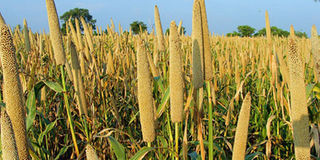Prices of finger millet ease

What you need to know:
- Data from the Ministry of Industry, Trade and Investment for October 10 have established that the decline in the wholesale price on Mainland Tanzania was due to increased supply
Dar es Salaam. The wholesale price of finger millet has eased by an average of eight per cent on Mainland Tanzania during the last three months, a survey has shown.
Data from the Ministry of Industry, Trade and Investment for October 10, have shown that prices of a 100-kilo bag of finger millet decreased to an average of Sh116,000 from Sh136,000 in early July. They have also indicated that the lowest price was recorded in Ruvuma and Arusha regions where a 100-kilo bag was sold at Sh80,000.
The report shows Kilimanjaro had the highest price of up to Sh200,000.
A survey has established that the decline in wholesale prices of finger millet on Mainland Tanzania was due to increased supply.
At Tandika, Kariakoo and Temeke-Double Cabin markets, the survey showed that the wholesale price of a 100-kilo bag of finger millet fell to Sh140,000 on October 10, from Sh160,000 in early July.
Retail prices for one kilo fell to Sh1,500 from Sh2,000 during the period. A retailer and wholesaler at Temeke Double Cabin Market, Mr Peter Kato, attributes the trend to a rise in supplies.
“I receive up to 130 bags a week, compared with 50 bags in July,” he said. Nutritionists say finger millet is especially valuable as it contains the amino acid methionine, which is lacking in the diets of hundreds of millions of the poor who live on starchy staples such as cassava, plantain, polished rice, or maizemeal.
Finger millet can be ground and cooked into cakes, puddings or porridge.
The grain is made into a fermented drink (or beer) in Nepal and in many parts of Africa. The straw from finger millet is used as animal fodder. It is also used for a flavored drink in festivals.
Nutritional value of finger millet per 100g




